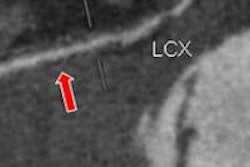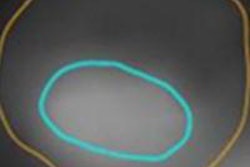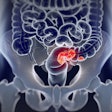
CHICAGO - 320-detector-row CT diagnoses in-stent restenosis accurately, even in small stents, researchers from Japan reported in a Sunday session at the RSNA annual meeting.
After scanning nearly 200 patients for significant in-stent restenosis (SISR) over a two-year period, the group found that 320-detector-row CT yielded high accuracy for stenosis detection -- even in stents smaller than 3 mm.
"320-detector-row CT has high accuracy in detecting significant in-stent restenosis, at 96%, and it is especially useful for excluding disease," said cardiologist Dr. Mio Uno from Mie University.
Stenting is a mainstay in the treatment of coronary artery disease, the No. 1 killer of adults, but the patency of stents is very difficult to assess using conventional CT, she said. While thrombosis can occur soon after stent implantation, SISR can develop later on in as many as 35% of patients receiving stents.
"As a result, early detection of SISR is critical for patient care," she said. CT is the best method of assessing stent patency, but it suffers from limitations including the presence of blooming artifacts when calcium is present, which reduces interpretation accuracy, and the vagaries of subjective interpretation.
A 2009 meta-analysis using 64-detector-row CT showed overall sensitivity and specificity in the low 90% range among assessable stents, but accuracy "fell dramatically" into the mid-80% range when all stents in the study population were included, Uno said.
The current study aimed to assess the diagnostic accuracy of 320-detector-row CT (Aquilion One, Toshiba Medical Systems) for detecting SISR, with conventional angiography as the reference standard.
Between August 2010 and October 2012, the group examined 189 patients (mean age, 56.6 years; range, 35-79 years) scheduled for invasive angiography, for a total of 319 stents. The interval between the last stent implantation and CT ranged from 3.6 to 6.6 months (mean, 11.2 months). The patients had a mean body mass index (BMI) of 27.2 kg/m2.
Beta-blockers were administered to reduce heart rates to 65 beats per minute or less, and patients received 60 mL of iodinated contrast and a saline chaser. Prospectively triggered images were acquired at 65% to 80% of the RR interval for the one-heartbeat scans given to 93% of patients; images were acquired at 35% for the remaining 7% of patients with higher heart rates who were scanned in two to three beats. The mean heart rate was 51 beats per minute, and the mean effective radiation dose was 5.3 mSv. Vessels were analyzed in two planes on a workstation.
Invasive angiography was performed within three days of CT, and two experienced radiologists reviewed all images in consensus. Stenosis of 50% or greater was deemed significant.
SISR was found in 18 (9.5%) of the 189 patents and in 25 (7.9%) of 318 stents. Overall diagnostic accuracy was 96%. Fully half of the stents analyzed were smaller than 3 mm in diameter, and a separate analysis of stents larger and smaller than 3 mm showed no difference in diagnostic accuracy between the two size thresholds, Uno said in response to a question from the audience.
| 320-detector-row CT for SISR detection | |||||
| Per stent | Per patient | ||||
| Sensitivity | 92% | 94% | |||
| Specificity | 96% | 96% | |||
| Positive predictive value | 66% | 74% | |||
| Negative predictive value | 99% | 99% | |||
| Accuracy | 96% | 96% | |||
"We sought to determine the significant cofactors in SISR, and we found that the number of stents per patients, lesion site at the right coronary artery, and bare metal stents were significantly correlated to the development of SISR," Uno said.
The study is the largest series undertaken on 320-detector-row CT, and the results are slightly better than those achieved on other scanner types -- in fact, the study showed the highest overall accuracy in any series to date, she said.
320-detector-row CT has high accuracy in assessing significant in-stent restenosis, at 96%, though the 74% per-patient positive predictive value isn't entirely satisfactory, Uno said. But the technique is certainly a reliable diagnostic tool in the assessment of SISR, she said.
And with its high negative predictive value of 99%, "we can use it safely to rule out SISR," she noted.




















